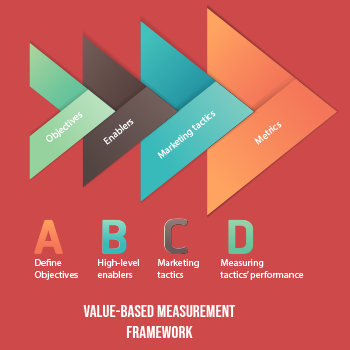Identifying website measurement metrics using a value tree approach
There is no perfect way to measure business performance. “If you cannot measure it, you cannot improve it,” maybe an oft-repeated cliché, but it remains as true as ever. The importance of monitoring and tracking metrics is vital to steer the overall strategy of the company. But with the exceedingly large amount of data points that a typical website generates today, marketers can easily get overwhelmed by metrics if there is no strategic context to measure.
Identifying the right metrics can help any company understand the value and effectiveness of its sales and marketing channels and to make business decisions to improve. The trick, of course, lies in identifying and agreeing on what is ‘right’.
In this document, we outline a value-based approach that marketers can deploy to identifying metrics that apply to their specific business context including desired business outcomes, and budget/time/resource constraints.
What is a value tree?

Steps in building a value tree
The four steps outlined here follow a common pattern regardless of the industry or business model for which a measurement strategy is being devised. Each step focuses on laying down the platform for defining the subsequent one as discussed below.
Step 1-Defining business objectives
The range of business variations even within a SaaS business model is huge. Some common considerations to hone in on specific objectives could include-
- Is the business selling a product or a service?
- Are we trying to increase loyalty or are we trying to ramp up traffic as part of an early-stage venture?
- Do we want to build awareness about the brand or is the focus on just conversions for the short term?
- Do we need to gather information about the audience or are we fine with just baskets full of cash?
- Do we want to generate leads through the website and sales happen offline as part of a long sales cycle?
- Do we want to distribute and disseminate knowledge and information?
- Do we want to offer customers online assistance and service?
- Where is the short-term operational focus? Is it on ROI or long-term customer lifetime value?
These are all critical questions that must be addressed through proper and detailed due diligence as the very first step of designing a website measurement strategy. Typically, the marketing objectives gleaned from this exercise are directional in nature i.e. improve sales, increase conversion rate, reduce churn, and so on but set the tone and context for the entire downstream set of activities.
A caveat here is that these objectives must gain universal acceptance across various stakeholders. This avoids common pitfalls later. The value-based framework therefore must begin with documenting these objectives to identify the most important drivers that will help us achieve these goals.
Step 2-Define enablers
Now that we know WHAT we need to do, we need to next define the HOW part. What are the high-level enablers for achieving the objectives? For example
- If the objective is to ramp up traffic, then we could run paid ad campaigns as opposed to spending time on SEO/Content marketing which is more of a long-term enabler for traffic.
- If the objective is to increase conversion rates, then a smaller proportion of the budget would go towards increasing traffic and more towards enablers like optimizing user experience, streamlining checkout, improving site navigation, publishing compelling content, etc.
- If a business already has a strong presence, and healthy sign-up rates, but needs to reduce churn, then the focus would shift away from purely website engagement to enablers like email marketing, promotions, cross/up-sell offers.
As can be seen, these enablers or high-level activity groups are vastly different depending upon the objectives established in the first step.
Step 3-Define marketing tactics
Tactics refer to the specific campaigns, programs, initiatives, or efforts that are deployed to implement the enablers. Be sure to include all tactics that come under the scope of each enabler. Even if there is no current plan to carry out a specific tactic, it might be implemented at a later time and should be mapped out. The Value Tree can in fact be used to present a business case and get funding to add a new marketing tactic. Here are a couple of examples of tactics derived from high-level enablers
 As can be seen, the kind of marketing tactics needed can be very different depending upon the specific enabler we are trying to implement.
As can be seen, the kind of marketing tactics needed can be very different depending upon the specific enabler we are trying to implement.
Step 4-Define metrics and KPIs
Now that we have defined at a granular level, the activities to be implemented, it is time to define measurement criteria. How will we measure the success of various tactics? It is helpful to build metrics to identify and prioritize high-level KPIs. Continuing the example above, we can define the following set of metrics

With the four steps now mapped out, the final value tree would look something like this.
The final value tree

Building out a value tree on the lines above should now provide a concrete reference framework for any actions and a clear cut path to achieving overall business outcomes. Setting aside budgets, assembling teams, deciding on the roles and responsibilities, and setting up the technology landscape should all now become far more contextual and meaningful.



